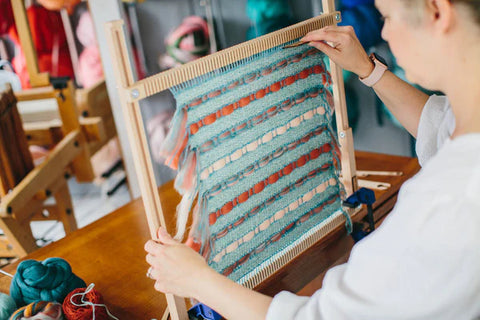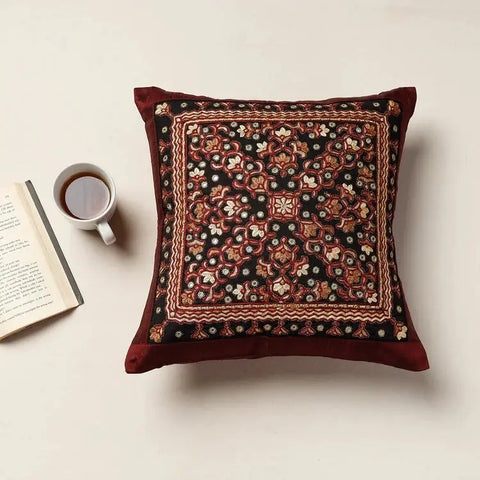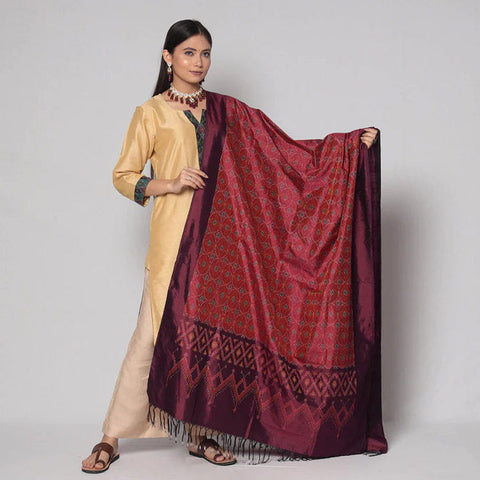 {Image credit:- The Hindu}
{Image credit:- The Hindu}
Handlooms regained popularity during the post-independence era when Mahatma Gandhi encouraged people to use handlooms instead of machine-made fabrics for their clothing needs because they were cheaper than machine-made textiles imported from abroad. This blog will discuss a brief history of handloom fabric, the different types, and their uses.
What Is A Handloom?
A 'handloom' is a type of loom that weaves cloth without the use of electricity. Hand weaving takes place in weavers' houses and generally involves interlacing two sets: warp (length) & weft (width).
There are two types of handlooms:
- pit looms
-
frame looms
Pit loom: This type of loom is usually found in rural areas, and it can be set up anywhere (in a room or outside) because it does not require electricity. It is made from bamboo or wood poles, with interwoven strips of cane used as the weave beams. There are also variations on pit looms that are more advanced but still use the same principle.
 {Image credit:- Pinterest}
{Image credit:- Pinterest}
Frame loom: This loom is used in urban areas and requires electricity. It is made from metal or wood frames with weave beams connected to them.
 {Image credit:- The oxford weaving studio}
{Image credit:- The oxford weaving studio}
Handloom is a traditional craft which is practised by millions of people around the world. It's a skill passed down from generation to generation, with each person adding their personal touch to work. Handloom is an art that uses natural dyes and depends on them for their beauty and vibrancy.
Handloom weaving first originated in ancient India. It was used as a form of resistance against foreign invaders and British colonists who sought to suppress native culture by banning everything from hand-spun cotton fabrics to silk saris woven by Indians.
Today, handloom weaving continues to play an important role in the lives of many Indians. Many rely on it as their primary source of income because they cannot afford expensive machines or clothing made overseas with cheap labour costs.
The History Of Handlooms In India
Handlooms are the oldest form of weaving, dating back thousands of years. Handlooms were used by nomads in Central Asia as early as 5000 BC. The widespread use of handloom fabrics began around 3000 BC after the invention of cotton.
Cotton was much more versatile than wool, making it easier to weave on handlooms. The first handlooms were frames made of wood and bamboo on which the weaver would sit while they worked. The warp threads were stretched across two lengths of wood, with one end secured to the ground and the other attached to a peg at the top of each frame. The weaver would then place the weft threads between these two lengths of wood and use a stick to push them backwards and forwards as they were woven.
The use of beater bars and treadles allowed the weaver to sit down and work instead of standing, thus significantly improving upon the process by which threads had previously been pushed by hand. However, it would still take a long time for one person to weave cloth in this manner.
Over time, weaving became an integral part of Indian culture. The Indians used handloom fabric for clothing needs—and its usage expanded rapidly.
The Decline of the Handlooms
Weaving was a way of life for many people in India until the early 19th century when industrial looms were introduced. Because the weavers could not afford or did not have access to capital loans needed for modern equipment, they gradually lost their traditional jobs as weaving became mechanised. Those who could still afford it found themselves working in sweatshops under poor conditions with low wages.
However, this trend was reversed by Mahatma Gandhi's campaign for khadi (a type of handloom). He believed that using khadi was a way to promote Indian Independence and self-reliance. The campaign was so successful that it led to an increase in demand for handlooms across India.
The handloom weavers of India continued to weave beautiful fabrics in their way, even as the world around them changed. By the mid-20th century, they had become a symbol of Indian culture and tradition. Handloom fabric is still widely used in India for making clothing and other items.
Handlooms In The Post-Independence Era
The handloom industry, an important source of livelihood for millions of people in India, became one of the largest rural employment sectors after Independence. The government's support for handlooms was crucial to their revival and growth.
However, with globalisation taking hold from the 1990s onwards, modern power looms emerged as an alternative to the traditional handloom sector due to their cheapness and efficiency. As a result, handloom production has steadily declined, and its share of total textile production is also down — leading to a significant fall in the number of weavers. Many have been forced into other occupations.
These include competition from power looms, reduced demand for traditional handwoven fabrics, and the need for access to inputs such as yarn and dyes. There are also issues related to quality control and marketing.
However, the handloom industry still has much potential if it is adequately supported to help India earn foreign exchange through exports and create better jobs for its people.
Revival Of Handlooms
To promote this traditional industry, the government of India has taken several initiatives.
- The rural employment guarantee act (MGNREGA) was enacted by parliament in 2006. It aims at providing the poor with an opportunity to work on public works projects and earn a regular income. The program has provided a chance for women who weave to increase their revenues.
- In December 2007, Prime Minister Manmohan Singh introduced the National Handloom Policy to promote this industry.
- In 2017, Prime Minister Narendra Modi launched a mission to help small-scale weavers modernise their craft by upgrading technology.
India's handloom sector has grown and evolved to hold a unique place in the export market: of all fabrics exported worldwide, 95% come from this country. In 2017-18, India exported handloom products worth US$ 353.9 million (EXIM Banks working paper 80, Indian handloom industry: potential and prospects). (1)
Types of Weaving Techniques
Several types of weaving techniques are used to create a wide range of fabrics. Some of the most common are:
- Plain weave: This simple weaving technique involves passing weft threads through a series of warp threads that lie horizontally across the loom. This type of weaving is used in making simple cloth like muslin, saris and cotton sheets. The fabric has a plain appearance with a smooth surface.
- Twill weave: A twill weave has diagonal lines running across it, creating a patterned design on both sides. Twills are typically used in denim; however, twill weaving can also be used for other purposes, such as curtains or tablecloths.
- Satin weave: A satin weave creates a smooth, lustrous fabric to make high-end clothing and tapestries. It involves using two sets of threads (usually warp and weft), where each group crosses over the other at regular intervals. The resulting fabric is smooth, soft and glossy.
- Jacquard weave: A Jacquard weave creates a patterned fabric using a series of warp threads held in place by heddles. The heddles can be raised or lowered to create patterns within the weave. This cloth is often used for making rugs and tapestries due to its durability and strength.
- Basket weave: A basket weave is a type of texture created when you interlace two threads, each collection consisting of three yarns. One group runs horizontally and one vertically; the third thread runs through both sets at an angle. It's often used for making baskets, mats, and clothing such as socks, hats and gloves.
Weaving styles in India are influenced by local culture and tradition
The Indian style of weaving has been heavily influenced by local culture and tradition; some common examples include the following:
-
Ikat: Ikat is a weaving method involving dyeing the warp before you weave it. The yarns are dyed using natural dyes and then woven into intricate patterns are used for clothing or home decor. The process takes weeks to complete, but the results are worth it because they're unique and beautiful.

-
Kutch: Kutch embroidery is a style of sewing that uses thread, beads, and sequins to create patterns on fabrics. The technique originated in the Kutch district of Gujarat state, which is why it's sometimes referred to as "Kutchi embroidery."

-
Bandhej: This style of weaving involves creating intricate patterns with cotton threads before dyeing them using natural dyes like madder root or turmeric. The designs are then applied to other materials like silk, cotton, and wool. The technique is commonly used in Rajasthan state to make shawls and scarves.

-
Pochampally: Pochampally is a style of weaving that uses natural dyes to create vibrant and colourful fabrics. The technique originated in Hyderabad, Telangana state and was traditionally used to make saris for women.

-
Jamdani: Jamdani weaving originated in Bengal state, where it's still popular today. It involves making intricate patterns with threads before dyeing them with natural dyes like indigo and madder roots.

Current Situation of Handloom Weavers
Handloom weavers are facing a lot of problems today. They need the right price for their work and the proper facilities to produce an attractive piece of cloth. The government is trying to revive the handloom industry by offering various schemes, including Hathkargha Samvardhan Sahayata (HSS), which has benefited many impoverished weavers.
The government has also allocated a compulsory budget for the handloom sector so that weavers can make better profits, but still, a lot more needs to be done. We must create awareness among people about the importance of handloom and how they can help these poor weavers by buying their products instead of opting for machine-made ones.
An Attempt To Preserve An Ancient Art Form—Handloom Weaving
Many brands are helping preserve this ancient art form and supporting its talented practitioners by allowing them to work on their terms.
One such company is itokri.com, which helps artisans sell handcrafted products—such as bedsheets, cushion covers and bags — to buyers worldwide.
iTokri has supported the work of more than 500 artisans, helping them to preserve their crafts and continue making beautiful handmade goods. It offers various products, from Punjab's famous phulkari dupattas to Andhra Pradesh's well-known ikkat sarees.
With over 100,000 listings of handmade items sourced from nearly 10,000 artisans across India, iTokri is the country's largest curated portal for art and handicraft products.
Creativity thrives in diverse populations, but small towns and villages need financial support from markets to maintain creative pursuits. Itokri helps weavers find customers who want to buy their products and provides them with the training and materials they need to improve their craft. The company has a network of weavers in several states that produce different types of textiles; some have worked in this field for years, while others just started recently.
Conclusion
The handloom industry in India is experiencing a revival. Many people are interested in learning about the history of this traditional method of weaving textiles, and some want to learn more about the process. We must preserve this ancient art form for future generations so they can understand how much work goes into making each piece of fabric.
Blogs you might also like:
know your handlooms
how to diffrenciate between handloom and powerloom
A new weave of life
Chanderi Weave: A Delicate Work Of Stunning Intricacy
 Verified Purchase
Verified Purchase






































Leave a comment (all fields required)